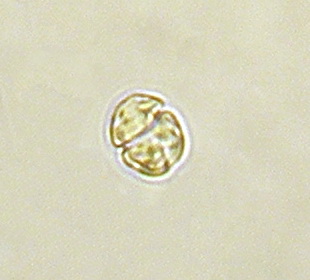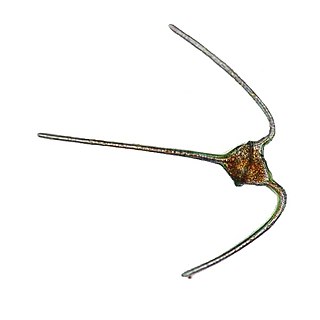
The dinoflagellates are monophyletic group of single-celled eukaryotes constituting the phylum Dinoflagellata and usually considered algae. Dinoflagellates are mostly marine plankton, but they also are common in freshwater habitats. Their populations vary with sea surface temperature, salinity, and depth. Many dinoflagellates are photosynthetic, but a large fraction of these are in fact mixotrophic, combining photosynthesis with ingestion of prey.

The Noctilucales are an order of marine dinoflagellates. They differ from most others in that the mature cell is diploid and its nucleus does not show a dinokaryotic organization. They show gametic meiosis.
The Syndiniales are an order of early branching dinoflagellates, found as parasites of crustaceans, fish, algae, cnidarians, and protists. The trophic form is often multinucleate, and ultimately divides to form motile spores, which have two flagella in typical dinoflagellate arrangement. They lack a theca and chloroplasts, and unlike all other orders, the nucleus is never a dinokaryon. A well-studied example is Amoebophrya, which is a parasite of other dinoflagellates and may play a part in ending red tides. Several MALV groups have been assigned to Syndiniales; recent studies, however, show paraphyly of MALVs suggesting that only those groups that branch as sister to dinokaryotes belong to Syndiniales.

Gymnodinium is a genus of dinoflagellates, a type of marine and freshwater plankton. It is one of the few naked dinoflagellates, or species lacking armor known as ellulosic plates. Since 2000, the species which had been considered to be part of Gymnodinium have been divided into several genera, based on the nature of the apical groove and partial LSU rDNA sequence data. Amphidinium was redefined later. Gymnodinium belong to red dinoflagellates that, in concentration, can cause red tides.

The genus Ceratium is restricted to a small number of freshwater dinoflagellate species. Previously the genus contained also a large number of marine dinoflagellate species. However, these marine species have now been assigned to a new genus called Tripos. Ceratium dinoflagellates are characterized by their armored plates, two flagella, and horns. They are found worldwide and are of concern due to their blooms.
Alexandrium fundyense is a species of dinoflagellates. It produces toxins that induce paralytic shellfish poisoning (PSP), and is a common cause of red tide. A. fundyense regularly forms massive blooms along the northeastern coasts of the United States and Canada, resulting in enormous economic losses and public health concerns.

The Gymnodiniales are an order of dinoflagellates, of the class Dinophyceae. Members of the order are known as gymnodinioid or gymnodinoid. They are athecate, or lacking an armored exterior, and as a result are relatively difficult to study because specimens are easily damaged. Many species are part of the marine plankton and are of interest primarily due to being found in algal blooms. As a group the gymnodinioids have been described as "likely one of the least known groups of the open ocean phytoplankton."

Ornithocercus is a genus of planktonic dinoflagellate that is known for its complex morphology that features considerable lists growing from its thecal plates, giving an attractive appearance. Discovered in 1883, this genus has a small number of species currently categorized but is widespread in tropical and sub-tropical oceans. The genus is marked by exosymbiotic bacteria gardens under its lists, the inter-organismal dynamics of which are a current field of research. As they reside only in warm water, the genus has been used as a proxy for climate change and has potential to be an indicator species for environmental change if found in novel environments.

Gonyaulax is a genus of dinoflagellates with the type species Gonyaulax spinifera Diesing. Gonyaulax belongs to red dinoflagellates and commonly causes red tides. It secretes a poisonous toxin known as "saxitoxin" which causes paralysis in humans.
Calcareous dinoflagellate cysts or calcareous dinocysts are dinoflagellate cysts produced by a group of peridinoid dinoflagellates, called calcareous dinoflagellates.
The Polykrikaceae are a family of athecate dinoflagellates of the order Gymnodiniales. Members of the family are known as polykrikoids. The family contains two genera: Polykrikos and Pheopolykrikos.

Erythropsidinium is a genus of dinoflagellates of the family Warnowiaceae.
Tripos elegans is a species of dinoflagellates in the family Ceratiaceae.

Gambierdiscus is a genus of marine dinoflagellates that produce ciguatoxins, a type of toxin that causes the foodborne illness known as ciguatera. They are usually epiphytic on macroalgae growing on coral reefs.

Polykrikos is one of the genera of family Polykrikaceae that includes athecate pseudocolony-forming dinoflagellates. Polykrikos are characterized by a sophisticated ballistic apparatus, named the nematocyst-taeniocyst complex, which allows species to prey on a variety of organisms. Polykrikos have been found to regulate algal blooms as they feed on toxic dinoflagellates. However, there is also some data available on Polykrikos being toxic to fish.
Blastodinium is a diverse genus of dinoflagellates and important parasites of planktonic copepods. They exist in either a parasitic stage, a trophont stage, and a dinospore stage. Although morphologically and functionally diverse, as parasites they live exclusively in the intestinal tract of copeods.
Coolia is a marine dinoflagellate genus in the family Ostreopsidaceae. It was first described by Meunier in 1919. There are currently seven identified species distributed globally in tropical and temperate coastal waters. Coolia is a benthic or epiphytic type dinoflagellate: it can be found adhered to sediment or other organisms but it is not limited to these substrates. It can also be found in a freely motile form in the water column. The life cycle of Coolia involves an asexual stage where the cell divides by binary fission and a sexual stage where cysts are produced. Some of the species, for example, Coolia tropicalis and Coolia malayensis, produce toxins that can potentially cause shellfish poisoning in humans.
Torodinium (ˌtɔɹoʊˈdɪniəm) is a genus of unarmored dinoflagellates and comprises two species, Torodinium robustum and the type species Torodinium teredo. The establishment of Torodinium, as well as the characterization of the majority of its morphology, occurred in 1921 and further advances since have been slow. Lack of research is largely due to its extremely fragile and easily deformed nature, which also renders fossil records implausible. The genus was originally characterized by torsion of the sulcus and a posterior cingulum. Since then, new distinctive features have been discovered including an extremely reduced hyposome, a longitudinally ribbed episome, and a canal on the dextro-lateral side. Further investigation into the function of many anatomical features is still necessary for this genus.
Dinophysaceae is a family of dinoflagellates in the class Dinophyceae.
Ostreopsis lenticularis is a species of dinoflagellate of the family Ostreopsidaceae described in 1981 by Yasuwo Fukuyo.









